Charles E W Bean, Diaries, AWM38 3DRL 606/275/1 - 1918 - 1938 - Part 14
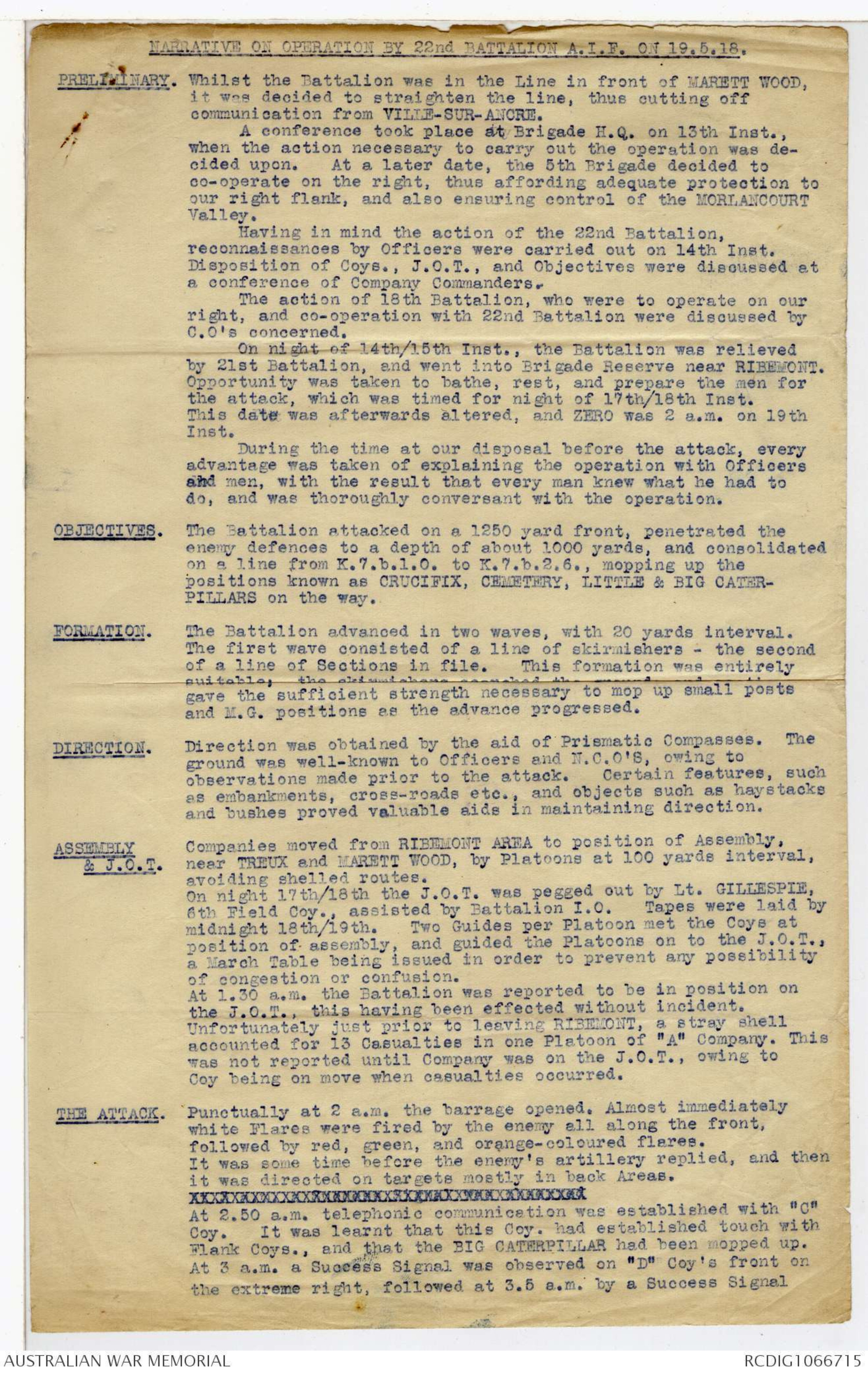
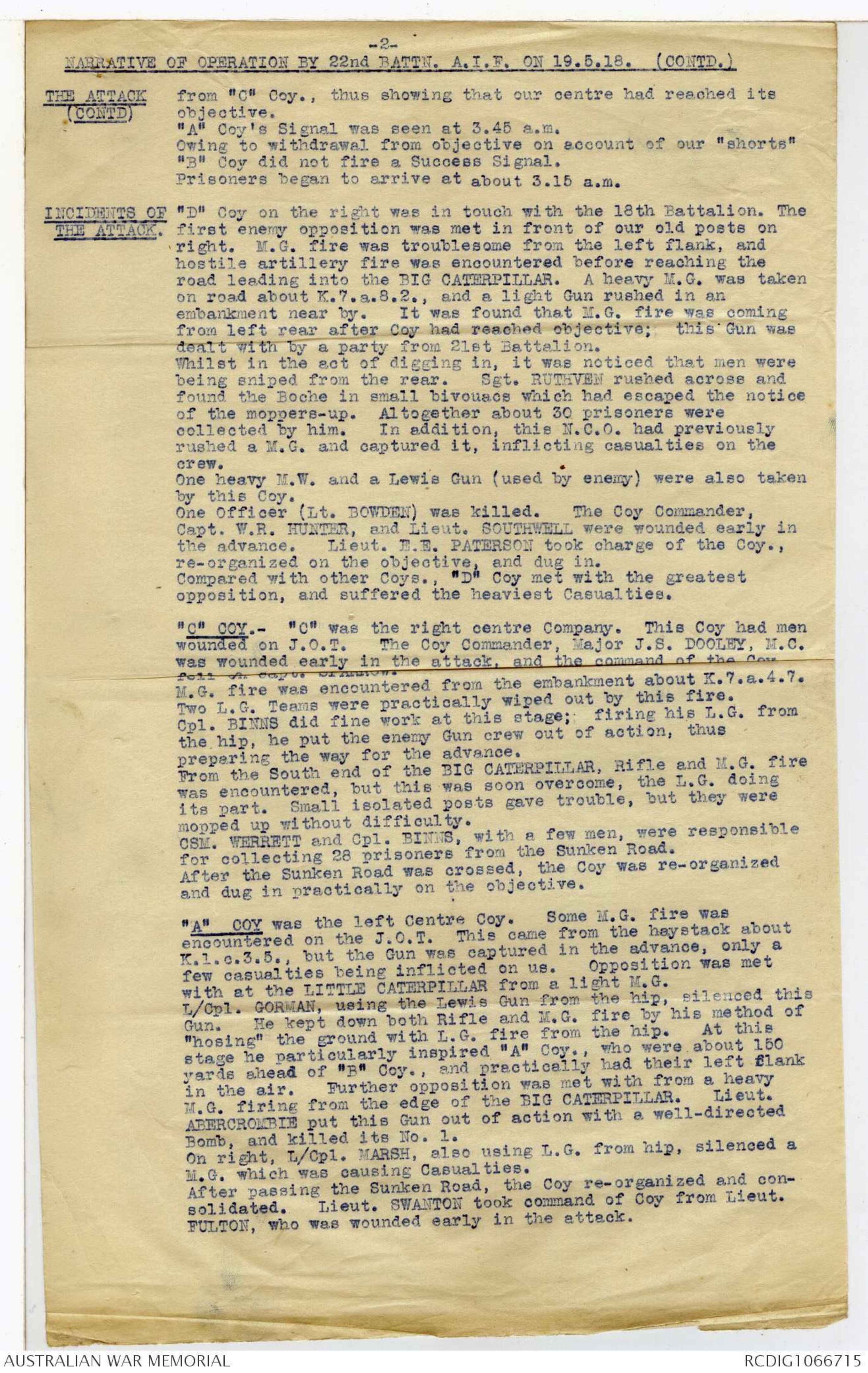

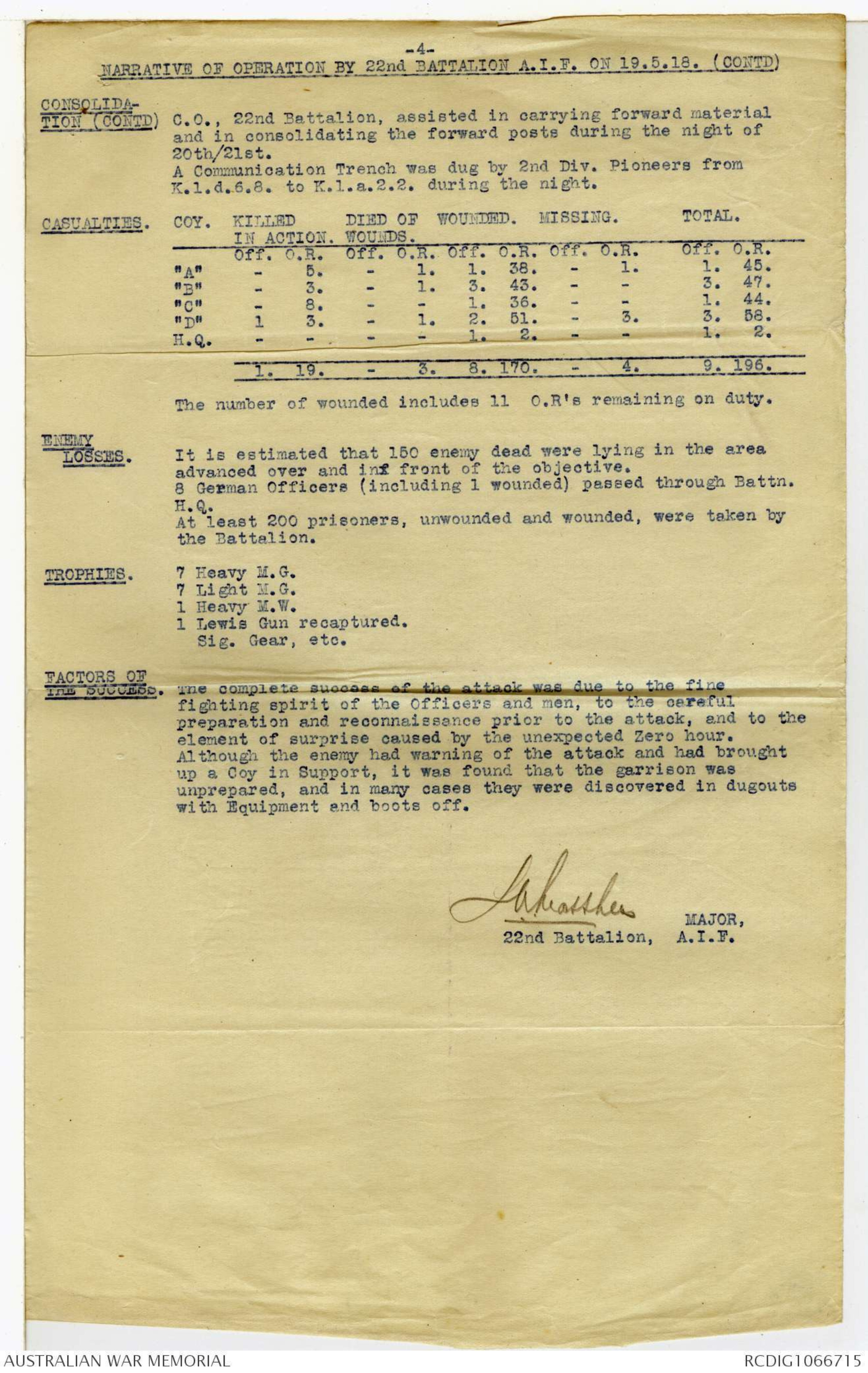
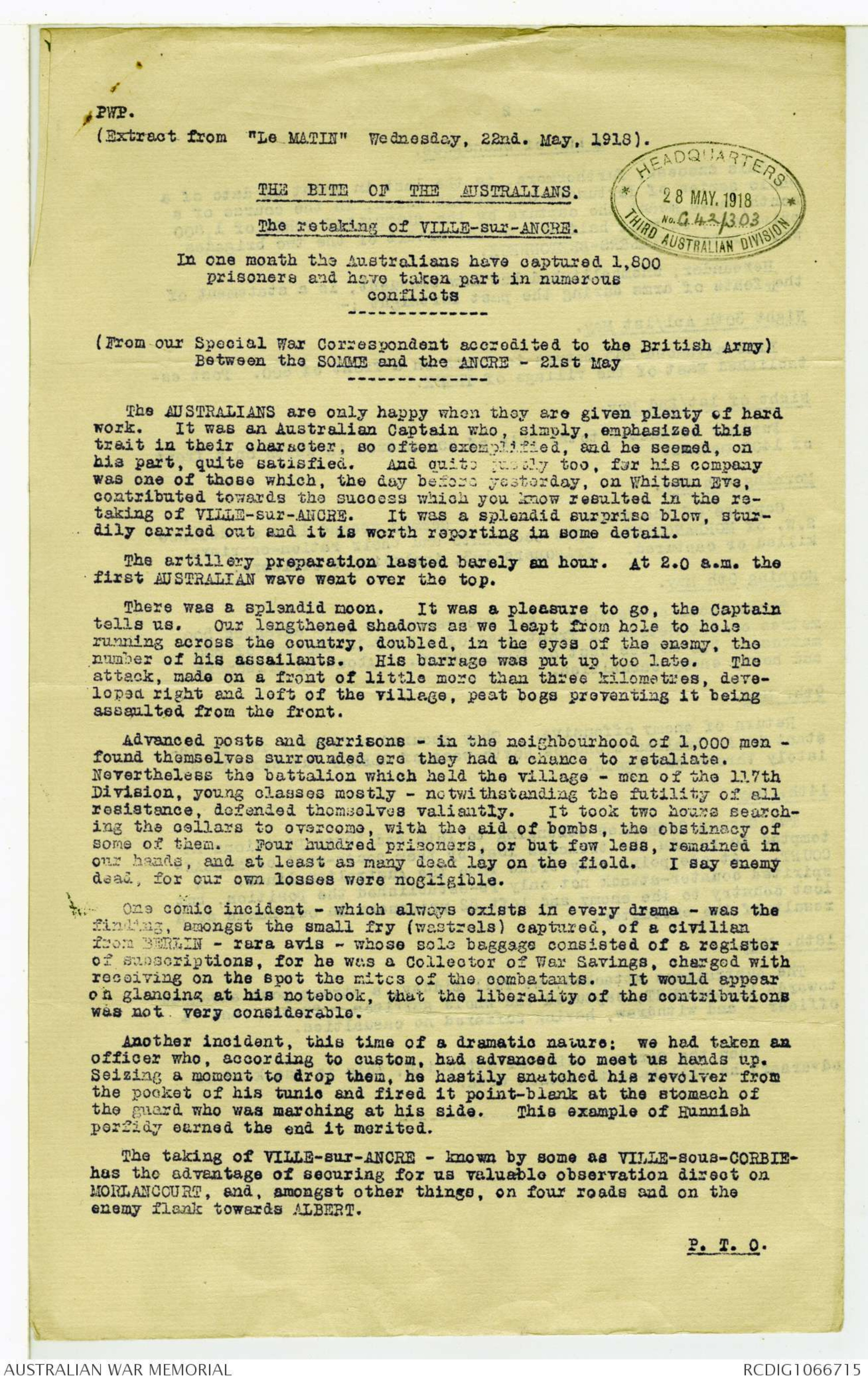
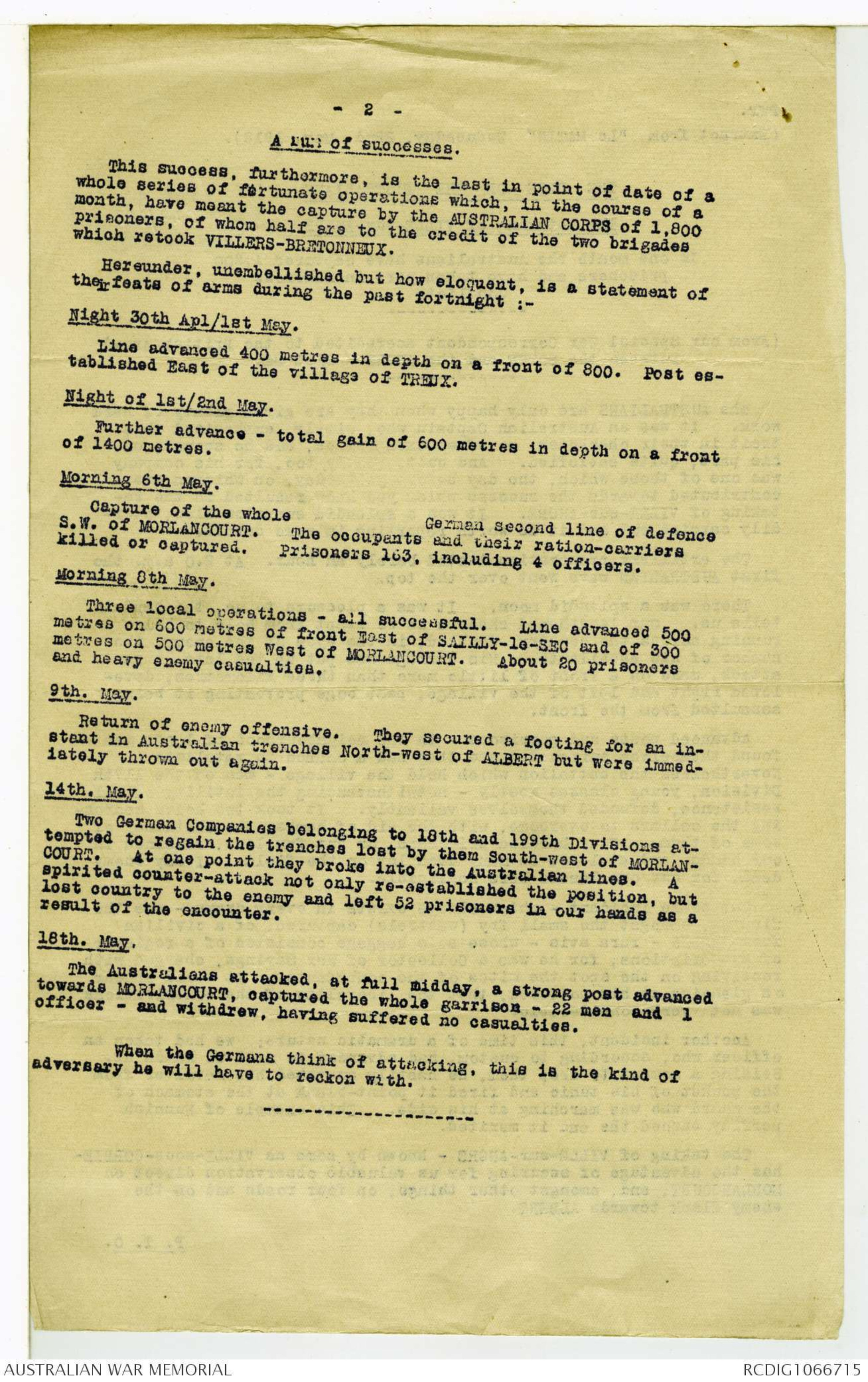
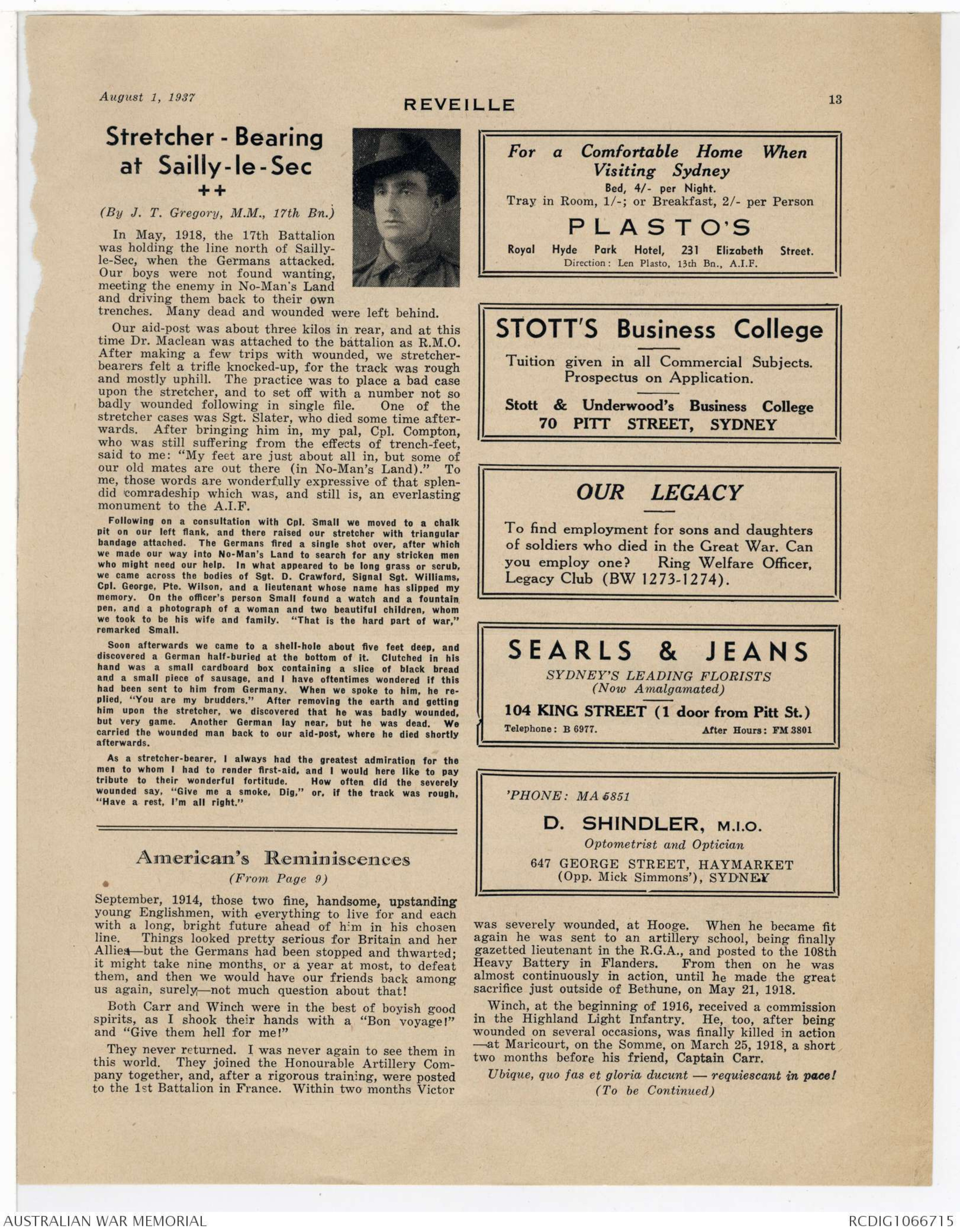
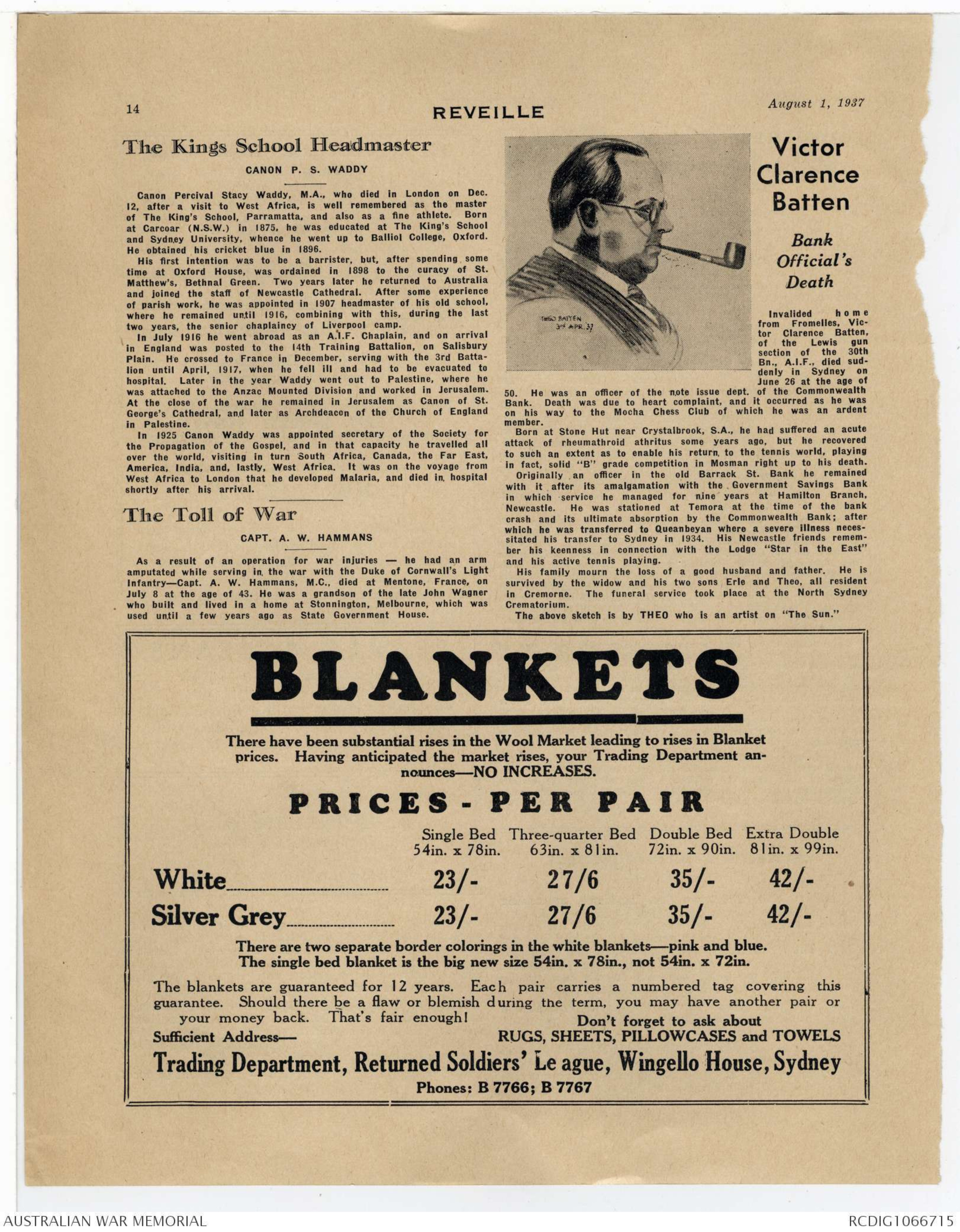
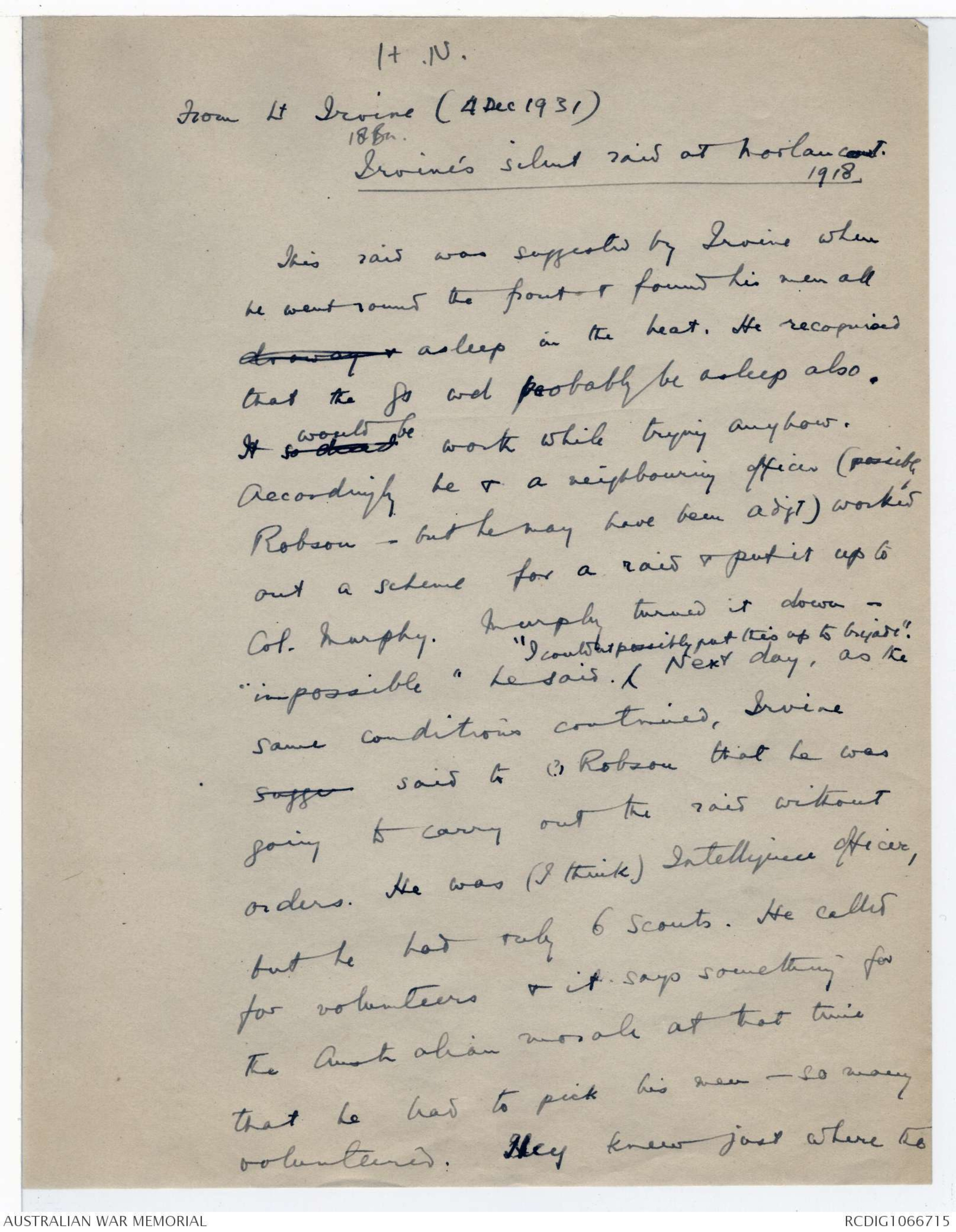
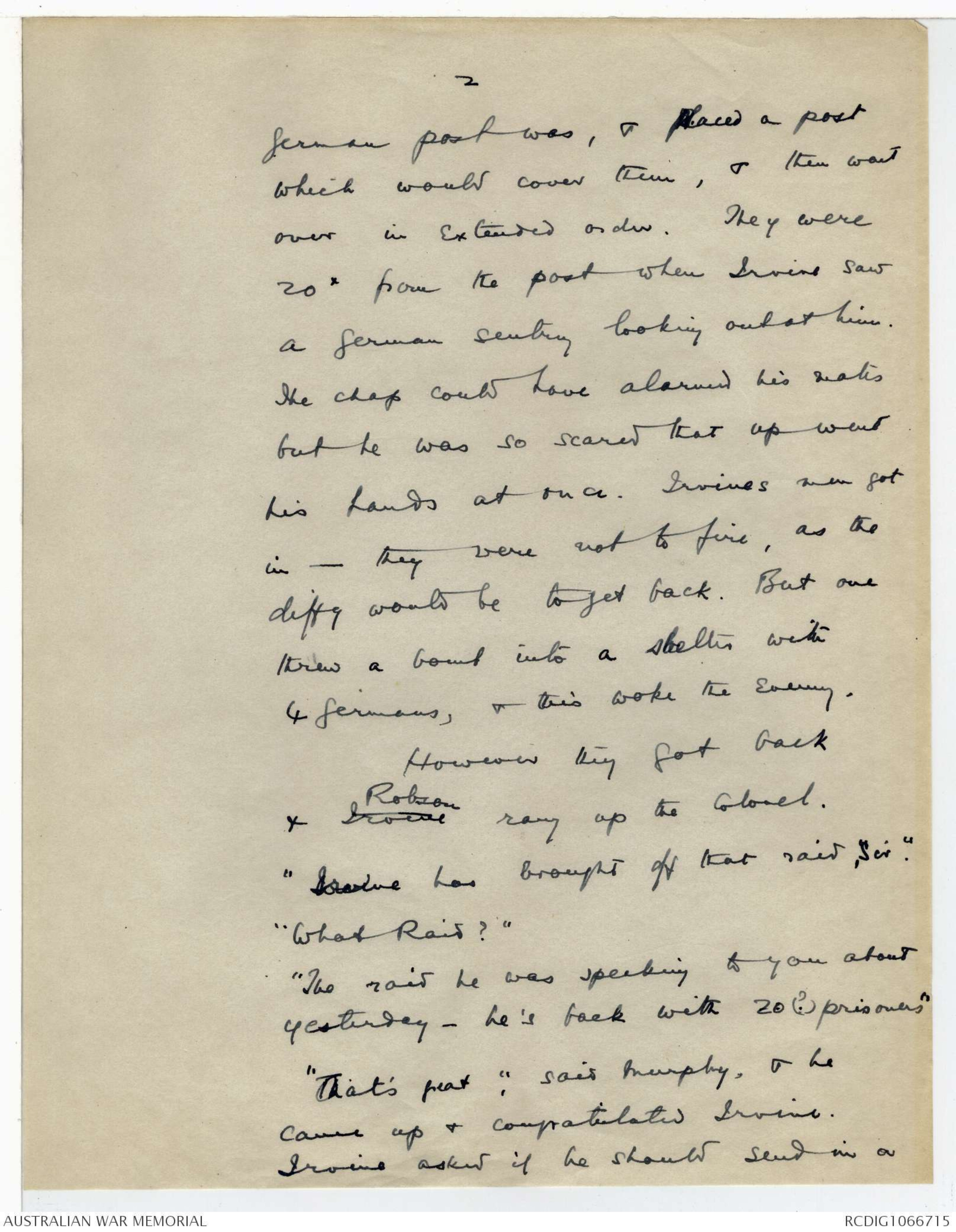
NARRATIVE OF OPERATION BY 22nd BATTALION A.I.F. ON 19.5.18.
PRELIMINARY. Whilst the Battalion was in the Line in front of MARETT WOOD,
it was decided to straighten the line, thus cutting off
communication from VILLE-SUR-ANCRE.
A conference took place at Brigade H.Q. on 13th Inst.,
when the action necessary to carry out the operation was decided
upon. At a later date, the 5th Brigade decided to
co-operate on the right, thus affording adequate protection to
our right flank, and also ensuring control of the MORLANCOURT
Valley.
Having in mind the action of the 22nd Battalion,
reconnaissances by Officers were carried out on 14th Inst.
Disposition of Coys., J.O.T., and Objectives were discussed at
a conference of Company Commanders.
The action of 18th Battalion, who were to operate on our
right, and co-operation with 22nd Battalion were discussed by
C.O's concerned.
On night of 14th/15th Inst., the Battalion was relieved
by 21st Battalion, and went into Brigade Reserve near RIBEMONT.
Opportunity was taken to bathe, rest, and prepare the men for
the attack, which was timed for night of 17th/18th Inst.
This date was afterwards altered, and ZER0 was 2 a.m. on 19th
Inst.
During the time at our disposal before the attack, every
advantage was taken of explaining the operation with Officers
and men, with the result that every man knew what he had to
do, and was thoroughly conversant with the operation.
OBJECTIVES. The Battalion attacked on a 1250 yard front, penetrated the
enemy defences to a depth of about 1000 yards, and consolidated
on a line from K.7.b.1.0. to K.7.b.2.6., mopping up the
positions known as CRUCIFIX, CEMETERY, LITTLE & BIG
CATERPILLARS on the way.
FORMATION. The Battalion advanced in two waves, with 20 yards interval.
The first wave consisted of a line of skirmishers - the second
of a line of Sections in file. This formation was entirely
suitable, the skirmishers [?]
gave the sufficient strength necessary to mop up small posts
and M.G. positions as the advance progressed.
DIRECTION. Direction was obtained by the aid of Prismatic Compasses. The
ground was well-known to Officers and N.C.O'S, owing to
observations made prior to the attack. Certain features, such
as embankments, cross-roads etc., and objects such as haystacks
and bushes proved valuable aids in maintaining direction.
ASSEMBLY & J.O.T. Companies moved from RIBEMONT AREA to position of Assembly,
near TREUX and MARETT WOOD, by Platoons at 100 yards interval,
avoiding shelled routes.
On night 17th/18th the J.O.T. was pegged out by Lt. GILLESPIE,
6th Field Coy., assisted by Battalion I.O. Tapes were laid by
midnight 18th/19th. Two Guides per Platoon met the Coys at
position of assembly, and guided the Platoons on to the J.O.T.,
a March Table being issued in order to prevent any possibility
of congestion or confusion.
At 1.30 a.m. the Battalion was reported to be in position on
the J.O.T., this having been effected without incident.
Unfortunately just prior to leaving RIBEMONT, a stray shell
accounted for 13 Casualties in one Platoon of "A” Company. This
was not reported until Company was on the J.O.T., owing to
Coy being on move when casualties occurred.
THE ATTACK. Punctually at 2 a.m. the barrage opened. Almost immediately
white Flares were fired by the enemy all along the front,
followed by red, green, and orange-coloured flares.
It was some time before the enemy's artillery replied, and then
it was directed on targets mostly in back Areas.At 3 a.m. a Success Signal was observed
At 2.50 a.m. telephonic communication was established with "C"
Coy. It was learnt that this Coy, had established touch with
Flank Coys., and that the BIG CATERPILLAR had been mopped up.
At 3 a.m. a Success Signal was observed on "D" Coy's front on
the extreme right, followed at 3.5 a.m. by a Success Signal
2
NARRATIVE OF OPERATION BY 22nd BATTN. A.I.F. ON 19.5.18. (CONTD.)
THE ATTACK (CONTD) from "C" Coy., thus showing that our centre had reached its
objective.
"A" Coy's Signal was seen at 3.45 a.m.
Owing to withdrawal from objective on account of our "shorts"
"B" Coy did not fire a Success Signal.
Prisoners began to arrive at about 3.15 a.m.
INCIDENTS OF THE ATTACK. "D" Coy on the right was in touch with the 18th Battalion. The
first enemy opposition was met in front of our old posts on
right. M.G. fire was troublesome from the left flank, and
hostile artillery fire was encountered before reaching the
road leading into the BIG CATERPILLAR. A heavy M.G. was taken
on road about K.7.a.8.2., and a light Gun rushed in an
embankment near by. It was found that M.G. fire was coming
from left rear after Coy had reached objective; this Gun was
dealt with by a party from 21st Battalion.
Whilst in the act of digging in, it was noticed that men were
being sniped from the rear. Sgt. RUTHVEN rushed across and
found the Boche in small bivouacs which had escaped the notice
of the moppers-up. Altogether about 30 prisoners were
collected by him. In addition, this N.C.O. had previously
rushed a M.G. and captured it, inflicting casualties on the
crew.
One heavy M.W. and a Lewis Gun (used by enemy) were also taken
by this Coy.
One Officer (Lt. BOWDEN) was killed. The Coy Commander,
Capt. W. R. HUNTER, and Lieut. SOUTHWELL were wounded early in
the advance. Lieut. E. E. PATERSON took charge of the Coy.,
re-organized on the objective, and dug in.
Compared with other Coys., "D" Coy met with the greatest
opposition, and suffered the heaviest Casualties.
"C" COY.- "C" was the right centre Company. This Coy had men
wounded on J.O.T. The Coy Commander, Major J. S. DOOLEY, M.C.
was wounded early in the attack, and the command of the Coy
fell to Capt. [?].
M.G. fire was encountered from the embankment about K.7.a.4.7.
Two L.G. Teams were practically wiped out by this fire.
Cpl. BINNS did fine work at this stage; firing his L.G. from
the hip, he put the enemy Gun crew out of action, thus
preparing the way for the advance.
From the South end of the BIG CATERPILLAR, Rifle and M.G. fire
was encountered, but this was soon overcome, the L.G. doing
its part. Small isolated posts gave trouble, but they were
mopped up without difficulty.
CSM. WERRETT and Cpl. BINNS, with a few men, were responsible
for collecting 28 prisoners from the Sunken Road.
After the Sunken Road was crossed, the Coy was re-organized
and dug in practically on the objective.
"A" COY was the left Centre Coy. Some M.G. fire was
encountered on the J.O.T. This came from the haystack about
K.1.c.3.5., but the Gun was captured in the advance, only a
few casualties being inflicted on us. Opposition was met
with at the LITTLE CATERPILLAR from a light M.G.
L/Cpl. GORMAN, using the Lewis Gun from the hip, silenced this
Gun. He kept down both Rifle and M.G. fire by his method of
"hosing" the ground with L.G. fire from the hip. At this
stage he particularly inspired "A” Coy., who were about 150
yards ahead of "B" Coy., and practically had their left flank
in the air. Further opposition was met with from a heavy
M.G. firing from the edge of the BIG CATERPILLAR. Lieut.
ABERCROMBIE put this Gun out of action with a well-directed
Bomb, and killed its No. 1.
On right, L/Cpl. MARSH, also using L.G. from hip, silenced a
M.G. which was causing Casualties.
After passing the Sunken Road, the Coy re-organized and consolidated
Lieut. SWANTON took command of Coy from Lieut..
FULTON, who was wounded early in the attack.
3
NARRATIVE OF OPERATION BY 22nd BATTN. A.I.F. ON 19.5.18. (CONTD)
INCIDENTS OF THE ATTACK. (CONTD) "B" COY. on left flank sent a fighting Patrol under Lieut.
MADIEN to mop up CEMETERY and CRUCIFIX on left. This was
satisfactorily done, and 2 M.G's and crews put out of action.
M.G. opposition was encountered at LITTLE CATERPILLAR, and a
L.G. Team was knocked out. Sgt. ROBINSON picked up the Gun
and worked it himself.
Owing to J.O.T. for "B" Coy being 150 yards in rear of general
J.O.T., "A" Coy had worked ahead of "B" Coy., and some
difficulty was experienced in keeping touch, the country being
rather difficult. In addition, both Officers of two right
Platoons and the N.C.O's who took over from them became
Casualties early in the advance.
Less opposition than was expected was encountered in the BIG
CATERPILLAR, and the Coy advanced to its objective, but had
to withdraw owing to our protective barrage falling short.
Some enfilade M.G. fire on the BIG CATERPILLAR was encountered
from the Village about 3.30 a.m., but 21st Battalion dealt
with this Gun.
Both phone and Lucas Lamp were damaged in this Coy, and it was
some time before the situation on the left became clear owing
to messages which had been sent by runner failing to reach
Battn. H.Q., and also to the fact that no Success Signal was
fired.
Reports of short shooting by our Artillery were received from
"B" Coy at 4 a.m., from "C" Coy at 4.55 a.m. and again at
7 a.m. Brigade were informed at once. The Casualties
suffered from our own Artillery fire were regrettable, and
marred an otherwise very successful operation
ENEMY MOVEMENT. Between 6 a.m. and 7.30 a.m. a great deal of movement was
observed on high ground in K.11 - K.10.c. ) E.26.b. - K.3.c. -
E.27.c., & K.2.b. It appeared as though the enemy was
bringing forward Troops for a counter-attack. The Artillery
were at once notified, and the places mentioned were
subjected to harassing fire.
Opposition on the part or the enemy was poor, at no place did
he put up a fight. A few isolated instances of M.G. crews
hanging on were met with, but these were quickly dispersed by
the Infantry, the crews being either killed or taken prisoner,
and the Guns put out of action.
VILLE-SUR-ANCRE was lightly shelled about 8 a.m. and at
10.30 a.m., the Village and the ground to the North were
subjected to heavy destructive fire. As a whole, the
Artillery retaliation throughout the attack was very light.
During the day word was sent through of enemy concentration at
E.26.b., K.3.c., E.27.c., and K.2.b., and these were effectively
dealt with by the Artillery.
COMMUNICATIONS. This was well maintained, both phone and runners being used.
A Visual Station was set up in the captured position, and was
available had it been required. On several occasions after
Brigade moved from Advanced H.Q., it took six to eight minutes
to get through on the phone, and even then it was difficult to
carry on conversation, the voice being very faintly heard.
PRISONERS. These began to arrive at Battn. H.Q. about two hours after the
attack commenced. When questioned they appeared to know very
little of VILLE-SUR-ANCRE, and had no idea of how strongly it
was garrisoned. They had been in this Sector for two days
only. The morale was very low.
The prisoners belonged to 52nd and 184th R.I.R.
CONSOLIDATION. With the exception of the left Coy, Posts were dug in on the
objective line while it was yet dark. During the day, a
personal reconnaissance of the whole forward position was made
and arrangements completed with the left Coy to move their
posts forward to pre-arranged positions as soon as possible
after nightfall, the remaining three Coys straightening their
line as required to conform with the general line of posts
along the whole front.
Two Coys 28th Battalion, which had been placed under orders of
-4-
NARRATIVE OF OPERATION BY 22nd BATTN. A.I.F. ON 19.5.18. (CONTD)
CONSOLIDATION (CONTD) C.O., 22nd Battalion, assisted in carrying forward material
and in consolidating the forward posts during the night of
20th/21st.
A Communication Trench was dug by 2nd Div. Pioneers from
K.1.d.6.8. to K.1.a.2.2. during the night.
CASUALTIES.
| COY. |
KILLED IN ACTION. |
DIED OF WOUNDS. |
WOUNDED. | MISSING. | TOTAL. | |||||
| Off. | O.R. | Off. | O.R. | Off. | O.R. | Off. | O.R. | Off. | O.R. | |
| ”A” |
- |
5. |
- |
1. |
1. |
38. |
- |
1. |
1. |
45. |
| ”B” |
- |
3. |
- |
1. |
3. |
43. |
- |
- |
3. |
47. |
| ”C” |
- |
8. |
- |
- |
1. |
36. |
- |
- |
1. |
44. |
| ”D” |
1. |
3. |
- |
1. |
2. |
51. |
- |
3. |
3. |
58. |
| H.Q. |
- |
- |
- |
- |
1. |
2. |
- |
- |
1. |
2. |
|
1. |
19. |
- |
3. |
8. |
170. |
- |
4. |
9. |
196. |
|
The number of wounded includes 11 O.R's remaining on duty.
ENEMY LOSSES. It is estimated that 150 enemy dead were lying in the area
advanced over and inf front of the objective.
8 German Officers (including 1 wounded) passed through Battn.
H.Q.
At least 200 prisoners, unwounded and wounded, were taken by
the Battalion.
TROPHIES. 7 Heavy M.G.
7 Light M.G.
1 Heavy M.W.
1 Lewis Gun recaptured.
Sig. Gear, etc.
FACTORS OF THE SUCCESS. The complete success of the attack was due to the fine
fighting spirit of the Officers and men, to the careful
preparation and reconnaissance prior to the attack, and to the
element of surprise caused by the unexpected Zero hour.
Although the enemy had warning of the attack and had brought
up a Coy in Support, it was found that the garrison was
unprepared, and in many cases they were discovered in dugouts
with Equipment and boots off.
[J A Matthews?]
MAJOR
22nd Battalion,
A.I.F.
[*HEADQUARTERS
25MAY.1918
No G42/303
THIRD AUSTRALIAN DIVISION*]
PWP.
(Extract from "Le MATIN", Wednesday, 22nd. May, 1918).
THE BITE OF THE AUSTRALIANS.
The retaking of VILLE-sur-ANCRE.
In one month the Australians have captured 1,800
prisoners and have taken part in numerous
conflicts.
(From our Special War Correspondent accredited to the British Army)
Between the SOMME and the ANCRE - 21st May
The AUSTRALIANS are only happy when they are given plenty of hard
work. It was an Australian Captain who, simply, emphasized this
trait in their character, so often exemplified, and he seemed, on
his part, quite satisfied. And quite justly too, for his company
was one of those which, the day before yesterday, on Whitsun Eve,
contributed towards the success which you know resulted in the retaking
of VILLE-sur-ANCRE. It was a splendid surprise blow, sturdily
carried out and it is worth reporting in some detail.
The artillery preparation lasted barely an hour. At 2.0 a.m. the
first AUSTRALIAN wave went over the top.
There was a splendid moon. It was a pleasure to go, the Captain
tells us. Our lengthened shadows as we leapt from hole to hole
running across the country, doubled, in the eyes of the enemy, the
number of his assailants. His barrage was put up too late. The
attack, made on a front of little more than three kilometres, developed
right and left of the village, peat bogs preventing it being
assaulted from the front.
Advanced posts and garrisons - in the neighbourhood of 1,000 men -
found themselves surrounded ere they had a chance to retaliate.
Nevertheless the battalion which held the village - men of the 117th
Division, young classes mostly - notwithstanding the futility of all
resistance, defended themselves valiantly. It took two hours searching
the cellars to overcome, with the aid of bombs, the obstinacy of
some of them. Four hundred prisoners, or but few less, remained in
our hands, and at least as many dead lay on the field. I say enemy
dead, for our own losses were negligible.
One comic incident - which always exists in every drama - was the
finding, amongst the small fry (wastrels) captured, of a civilian
from BERLIN - rara avis - whose sole baggage consisted of a register
of subscriptions, for he was a Collector of War Savings, charged with
receiving on the spot the mites of the combatants. It would appear
on glancing at his notebook, that the liberality of the contributions
was not very considerable.
Another incident, this time of a dramatic nature: we had taken an
officer who, according to custom, had advanced to meet us hands up.
Seizing a moment to drop them, he hastily snatched his revolver from
the pocket of his tunic and fired it point-blank at the stomach of
the guard who was marching at his side. This example of Hunnish
perfidy earned the end it merited.
The taking of VILLE-sur-ANCRE - known by some as VILLE-sous-CORBIE-
has the advantage of securing for us valuable observation direct on
MORLANCOURT, and, amongst other things, on four roads and on the
enemy flank towards ALBERT.
P.T.0.
2
A run of successes.
This success, furthermore, is the last in point of date of a
whole series of fortunate operations which, in the course of a
month, have meant the capture by the AUSTRALIAN CORPS of 1,800
prisoners, of whom half are to the credit of the two brigades
which retook VILLERS-BRETONNEUX.
Hereunder, unembellished but how eloquent, is a statement of
their feats of arms during the past fortnight:
Night 30th April/1st May.
Line advanced 400 metres in depth on a front of 800. Post
established East of the village of TREUX.
Night of 1st/2nd May.
Further advance - total gain of 600 metres in depth on a front
of 1400 metres.
Morning 6th May.
Capture of the whole German second line of defence
S.W. of MORLANCOURT. The occupants and their ration-carriers
killed or captured. Prisoners 163, including 4 officers.
Morning 8th May.
Three local operations - all successful. Line advanced 500
metres on 600 metres of front East of SAILLY-le-SEC and of 300
metres on 500 metres West of MORLANCOURT. About 20 prisoners
and heavy enemy casualties.
9th. May.
Return of enemy offensive. They secured a footing for an instant
in Australian trenches North-west of ALBERT but were immediately
thrown out again.
l4th. May.
Two German Companies belonging to 18th and 199th Divisions attempted
to regain the trenches lost by them South-west of MORLANCOURT.
At one point they broke into the Australian lines. A
spirited counter-attack not only re-established the position, but
lost country to the enemy and left 52 prisoners in our hands as a
result of the encounter.
18th. May.
The Australians attacked, at full midday, a strong post advanced
towards MORLANCOURT, captured the whole garrison - 22 men and 1
officer - and withdrew, having suffered no casualties.
When the Germans think of attacking, this is the kind of
adversary he will have to reckon with.
13
August 1, 1937 REVEILLE
Stretcher - Bearing
at Sailly-le-Sec
(By J. T. Gregory, M.M., 17th Bn.)
In May, 1918, the 17th Battalion
was holding the line north of Sailly-
le-Sec, when the Germans attacked.
Our boys were not found wanting,
meeting the enemy in No-Man's Land
and driving them back to their own
trenches. Many dead and wounded were left behind.
Our aid post was about three kilos in rear, and at this
time Dr. Maclean was attached to the battalion as R.M.O.
After making a few trips with wounded, we stretcher-
bearers felt a trifle knocked-up, for the track was rough
and mostly uphill. The practice was to place a bad case
upon the stretcher, and to set off with a number not so
badly wounded following in single file. One of the
stretcher cases was Sgt. Slater, who died some time afterwards.
After bringing him in, my pal, Cpl. Compton,
who was still suffering from the effects of trench-feet,
said to me: "My feet are just about all in, but some of
our old mates are out there (in No-Man's Land)." To
me, those words are wonderfully expressive of that splendid
comradeship which was, and still is, an everlasting
monument to the A.I.F.
Following on a consultation with Col. Small we moved to a chalk
pit on our left flank, and there raised our stretcher with triangular
bandage attached. The Germans fired a single shot over, after which
we made our way Into No-Man's Land to search for any stricken men
who might need our help. In what appeared to be long grass or scrub,
we came across the bodies of Sgt. D. Crawford, Signal Sgt. Williams,
Cpl. George, Pte. Wilson, and a Lieutenant whose name has slipped my
memory. On the officer's person Small found a watch and a fountain
pen, and a photograph of a woman and two beautiful children, whom
we took to be his wife and family. "That Is the hard part of war,"
remarked Small.
Soon afterwards we came to a shell-hole about five feet deep, and
discovered a German half-buried at the bottom of it. Clutched in his
hand was a small cardboard box containing a slice of black bread
and a small piece of sausage, and I have oftentimes wondered if this
had been sent to him from Germany. When we spoke to him, he replied,
"You are my brudders." After removing the earth and setting
him upon the stretcher, we discovered that he was badly wounded.
but very game. Another German lay near, but he was dead. We
carried the wounded man back to our aid-post, where he died shortly
afterwards.
As a stretcher-bearer, I always had the greatest admiration for the
men to whom I had to render first-aid, and would here to pay
tribute to their wonderful fortitude. Now often did the severely
wounded say, "Give me a smoke, Dig,” or, if the track was rough,
"Have a rest, I'm all right."
American's Reminiscences
(From Page 9)
September, 1914, those two fine, handsome, upstanding
young Englishmen, with everything to live for and each
with a long, bright future ahead of him in his chosen
line. Things looked pretty serious for Britain and her
Allies—but the Germans had been stopped and thwarted;
it might take nine months, or a year at most, to defeat
them, and then we would have our friends back among
us again, surely—not much question about that!
Both Carr and Winch were in the best of boyish good
spirits, as I shook their hands with a "Bon voyage!"
and "Give them hell for me!"
They never returned. I was never again to see them in
was severely wounded, at Hooge. When he became ft
this world. They joined the Honourable Artillery Company
together, and, after a rigorous training, were posted
to the 1st Battalion in France. Within two months Victor
was severely wounded, at Hooge. When he became fit
again he was sent to an artillery school, being finally
gazetted lieutenant in the R.G.A. and posted to the 108th
Heavy Battery in Flanders. From then on he was
almost continuously in action, until he made the great
sacrifice just outside of Bethune, on May 21, 1918.
Winch, at the beginning of 1916, received a commission
in the Highland Light Infantry. He, too, after being
wounded on several occasions, was finally killed in action
—at Maricourt, on the Somme, on March 25, 1918, a short
two months before his friend, Captain Carr.
Ubique, quo fas et gloria ducunt – requiescant in pace!
(To be Continued)
14
REVEILLE August 1, 1937
The King's School Headmaster
CANON P. S. WADDY
Canon Percival Stacy Waddy, M.A. who died Ia London on Dec.
12, after a visit to West Africa, is well remembered as the master
of The King's School, Parramatta, and also as a fine athlete. Born
at Carcoar (NS.W.) in 1875. he was educated at The King's School
and Sydney University, whence he went up to Balliol College, Oxford.
He obtained his cricket blue in 1896.
His first intention was to be a barrister, but, after spending some
time at Oxford House, was ordained in 1898 to the curacy of St.
Matthew's, Bethnal Green. Two years later he returned to Australia
and joined the staff of Newcastle Cathedral. After some experience
of parish work, he was appointed in 1907 headmaster of his old school
where he remained until 1916, combining with this, during the last
two years, the senior chaplaincy of Liverpool camp.
In July 1916 he went abroad as an A.I.F. Chaplain, and on arrival
in England was posted to the 14th Training Battalion, on Salisbury
Plain. He crossed to France in December, serving with the 3rd Battalion
until April, 1917, when he fell ill and had to be evacuated to
hospital. Later in the year Waddy went out to Palestine, where he
was attached to the Anzac Mounted Division and worked in Jerusalem.
At the close of the war he remained in Jerusalem as Canon of St.
George's Cathedral, and later as Archdeacon of the Church of England
in Palestine.
In 1925 Canon Waddy was appointed secretary of the Society for
the Propagation of the Gospel, and in that capacity he travelled all
over the world, visiting in turn South Africa, Canada, the Far East,
America, India, and, lastly, West Africa. It was on the voyage from
West Africa to London that he developed Malaria, and died In hospital
shortly after his arrival.
The Toll of War
CAPT. A, HAMMANS
As a result of an operation for war injuries – he had an arm
amputated while serving in the war with the Duke of Cornwall's Light
Infantry—Capt. A. W. Hammans, M.C., died at Mentone, France, on
July 8 at the age of 43. He was a grandson of the late John Wagner
who built and lived in a home at Stonnington, Melbourne, which was
used until a few years ago as State Government House.
Victor
Clarence
Batten
Bank
Officials
Death
Drawing - see original document
Invalided home
from Fromelles. Victor
Clarence Batten,
of the Lewis gun
section of the 30th
Bn. A.I.F. died suddenly
in Sydney on
June 26 at the age of
50. He was an officer of the note issue dept, of the Commonwealth
Bank. Death was due to heart complaint, and it occurred as he was
on his way to the Mocha Chess Chub of which he was an ardent
member.
Born at Stone Hut near Crystalbrook, S.A. he had suffered an acute
attack of rheumathroid athritus some years ago, but he recovered
to such an extent as to enable his return to the tennis world, playing
in fact, solid "B" grade competition in Mosman right up to his death.
Originally an officer in the old Barrack St. Bank he remained
with it after its amalgamation with the Government Savings Bank
in which service he managed for nine years at Hamilton Branch,
Newcastle. He was stationed at Temora at the time of the bank
crash and its ultimate absorption by the Commonwealth Bank; after
which he was transferred to Queanbeyan where a severe illness necessitated
his transfer to Sydney in 1934. His Newcastle friends remember
his keenness in connection with the Lodge "Star in the East"
and his active tennis playing.
His family mourn the loss of a good husband and father. He is
survived by the widow and his two sons Eric and Theo, all resident
in Cremorne. The funeral service took place at the North Sydney
Crematorium.
The above sketch is by THEO who is an artist on "The Sun."
H.N.
From Lt Irvine (4 Dec 1931)
18 Bn
Irvine's silent raid at Morlancourt. 1918
This raid was suggested by Irvine when
he went round the front & found his men alldrowsy & asleep in the heat. He recognised
that the Gs wd probably be asleep also.
It so decd would be worth while trying anyhow.
Accordingly he & a neighbouring officer (possibly
Robson - but he may have been adjt) worked
out a scheme for a raid & put it up to
Col. Murphy. Murphy turned it down -
"impossible" he said. "I couldnt possibly put this up
to brigade". Next day, as the
same conditions continued, Irvine
sugges said to (?) Robson that he was
going to carry out the raid without
orders. He was (I think) Intelligence Officer,
but he had only 6 scouts. He called
for volunteers & it says something for
the Australian morale at that time
that he had to pick his men – so many
volunteered. They knew just where the
2
German post was, & placed a post
which would cover them, & they went
over in extended order. They were
20x from the post when Irvine saw
a German sentry looking out at him.
The chap could have alarmed his mates
but he was so scared that up went
his hands at once. Irvines men got
in — they were not to fire, as the
diffy would be to get back. But one
threw a bomb into a shelter with
4 Germans , & this woke the enemy.
However they got back
& Irvine Robson rang up the Colonel.
"Irvine has brought off that raid, Sir".
"What raid?"
"The raid he was speaking to you about
yesterday - he's back with 20 (?) prisoners"
"That's great," said Murphy, & he
came up & congratulated Irvine.
Irvine asked if he should send in a
 Sam scott
Sam scottThis transcription item is now locked to you for editing. To release the lock either Save your changes or Cancel.
This lock will be automatically released after 60 minutes of inactivity.